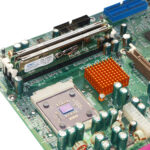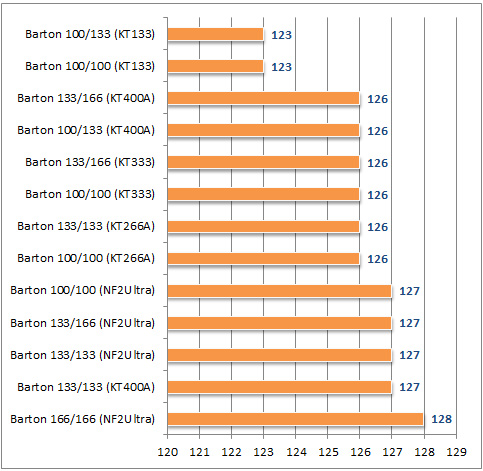First & Last AMD Socket A Athlons – Thunderbird vs. Barton – Part 2
Continuing our exploration of the evolution of the Socket A architecture. See Part 1 here
Test Stand
 For tests of all processors with a final frequency of 1 GHz, several processor / RAM operating modes were selected: 100/100, 100/133, 133/133, 133/166 MHz, priority was given to modes with the highest RAM frequency.
For tests of all processors with a final frequency of 1 GHz, several processor / RAM operating modes were selected: 100/100, 100/133, 133/133, 133/166 MHz, priority was given to modes with the highest RAM frequency.
The main components of the system:
CPUs:
AMD Athlon XP-М, (10x 100 и 7.5x 133) 1000 MHz, Barton
AMD Athlon (B), (10x 100) 1000 MHz, Thunderbird
AMD Athlon (C), (7.5x 133) 1000 MHz, Thunderbird
Motherboards:
- ASUS A7V, chipset VIA Apollo KT133
- ABIT KR7A, chipset VIA KT266A
- EPOX EP-8K3A, chipset VIA KT333
- EPOX EP-8K9A7I, chipset VIA KT400A
- EPOX EP-8RDA3I, chipset Nvidia NForce 2 Ultra 400
Memory:
- OCZ PC3200 EL Platinum Edition (OCZ4001024ELDCPE-K), 512 Мб х2 (PC3200) CL=2
Videocard
- Gainward – GeForce 6800 Ultra AGP 256 Mb (Forceware 81.85).
Testing was carried out in Windows XP Sp3 using the following software:
• Super Pi mod. 1.5XS (1M task)
• PiFast v.4.1
• WinRAR x86 v. 5.40
• Cinebench 2003
• 3Dmark2001SE Pro b330
• 3DMark 2003 v.3.6.1
• AIDA64 5.50.3600
• PCMark 2004 v.1.30
• Max Payne
• Far Cry
• DOOM III
Tests
When testing all platforms, I used the same Windows XP SP3 distribution with the same list of running services and settings. Gainward GeForce 6800 Ultra AGP 256 MB together with Kingston V300 60 GB SSD remained unchanged companions throughout the tests. Windows XP SP3 was installed from scratch for each platform. All VIA chipsets used VIA Hyperion 4-in-1 Driver version 4.51. For the video card – Forceware 81.85. All unnecessary services were disabled, the system was tuned to high performance mode.
Super Pi mod. 1.5XS (1M task)
Minutes (less is better)
The difference between the generations of processors and the total lag of the system based on the KT133 chipset with SDRAM are immediately striking. The Athlon, based on the “Thunderbird” core, feels very comfortable on a motherboard with a chipset from Nvidia, although this applies equally to all test participants. Moving from the KT133 at 100/100 to the nForce board resulted in a 51% increase in speed, with the same exact CPU. Comparing Thunderboard to Barton, on the KT133 at the same FSB/Mem is around a 43% increase in speed. If we combine faster CPU architecture and faster chipset (Barton on nForce vs T-Bird on KT133) we see a 67% speed difference. This shows the ‘platforms’ evolution in speed. The synchronous mode of operation of the system bus with RAM is more useful than asynchronous.
PiFast v.4.1
Seconds (less is better)
Everything is practically the same here, the only remark is that “Barton” has slightly lost ground in relation to the previous test. If we use our platform comparison as above, we see the Barton/nForce is now only 40% faster than the T-bird/KT133.
WinRAR x86 v. 5.40
Kb/sec (more is better)
WinRAR is really a throughput test, so memory comes into play a lot more here, and DDR vs SDRAM makes a big difference. The Barton/nForce is nearly 90% faster then the old T-bird/KT133. If we compare T-bird and Barton on the same nForce platform, we see the difference is only 32%. THe T-bird benefits greatly from the DDR memory.
Cinebench 2003
points (more is better)
We could not see a fierce struggle in this test. But it is clear that the system with SDRAM memory loses three points at once to everyone else. All processors based on the Nvidia NForce 2 Ultra 400 chipset and the VIA KT400A platform with 133/133 synchronous operation managed to score 127 points. If suddenly someone asks, where is the “Thunderbird” in this test? My answer is that Cinebench 2003 needs support for SSE instructions, while Athlon “Thunderbird” lacks them.
3DMark 2001 SE Pro b330
Total score (more is better)
On the example of “Thunderbird” and “Barton” 100/100, it can be seen that the ABIT motherboard on the KT266A chipset, due to its rich settings in the BIOS, is better than the EPOX on the older VIA KT333 chipset. Out platform comparison here shows the Barton/nForce as around 40% faster thent he T-bird/KT133 here. Moving from T-bird to Barton on the same platform (nForce) resulted in only a 5-6% increase.
3Dmark 2003 v.3.6.1
Total score (more is better)
In 3Dmark 2003, where the final score depends more on the video card than on all other components all together, the opposition between Nvidia NForce 2 and VIA KT400A is interesting. It is clear that the processor frequency is not enough to reveal the full potential of the video card, but the more interesting is the struggle, where the other components of the system play a key role at the same frequency. Also interesting is the KT266A chipset performs better thent he newer KT333 in this test.
AIDA64 5.50.3600
Memory write, Mb/s
Reading + writing. This is obviously going to favor DDR and faster memory speeds. The memory controller in the CPUs still makes a bit of difference though (as well as caching). The Barton comes out 10% or so faster then the T-bird on the same board.
Below is a screenshot of the Cache and Memory benchmark from the AIDA64 test suite for clarity. Notice that while the Barton and T-bird have roughly the same cache throughput, the Barton has a latency penalty of roughly 4 times that of the T-bird. Both the T-bird and Barton are 16-way set associative, but the Barton has 512K vs the T-birds 256K. This latency difference helps the T-bird out in some of the benchmarks.
PCMark 2004 v.1.30
points (more is better)
You will not see the results of Athlon XP on the Barton core in this test on the VIA KT133 platform. This is the only test that refused to run with it. Here the Barton/nForce is only 23% Faster then the T-bird/KT133.
| Max Payne (1280 x 1024, PCGH’s Final Scene No.1 (VGA-Demo)) Average result, frames/sec |
Far Cry (1024×768, Max Quality, demo 3DNews – Research, 3x loop) Average result, frames/sec |
 |
 |
Both of these are pretty similar with the Barton/nForce scoring 33% and 41% faster. ON the same chipset, the 2 CPUs are only around 5% different. Far Cry is probably not going to be a lot of fun to play on any of these system though, pushing only 26FPS max.
DOOM III (1024×768, High Quality, AA4x, timedemo1, 3x loop)
Average result, frames/sec
Doom also needs support for SSE instructions, so the owners of Athlon “Thunderbird” processors are left out, but the table of ranks of all chipsets is clearly visible. Here you can see almost the whole essence of what is happening, which shows that it is not only the hardware (chipset) itself that is important, but also the software capabilities that engineers have incorporated into the BIOS in order to unleash the full potential of the chipset manufacturer. On the example of a motherboard made by ABIT with the KT266A chipset, it is clear that they have succeeded in full, beating out the KT333, but the engineers from EPOX have not done near as well. Actually, this approach works to this day, therefore, when approaching the choice of a motherboard, you should not be too cheap.
The operation of various modes of RAM clearly shows that all chipsets have much better results in synchronous mode than in asynchronous mode, although this does not apply to the case with KT133, where SDRAM bandwidth is clearly not enough and asynchronous mode is beneficial.
Conclusion
 The whole life of the Socket A platform was bright and interesting. There is a large abundance of chipsets and processors with the ability to unlock the multiplier and other parameters, but the most important thing is the continuity and support, albeit not 100%, of motherboard manufacturers throughout the life of Socket 462, of all processors released for this socket. Now the situation is somewhat different, if Intel has long weaned users from such comfort and the need to change the motherboard exists in a generation, then the situation with AMD is still better, but it is far from the ideal that was before. This industry-wide behavior can be partly attributed to the complexity of the design and implementation of modern processor architectures, and possibly to marketing research, which has long become dominant, and perhaps all of the above.
The whole life of the Socket A platform was bright and interesting. There is a large abundance of chipsets and processors with the ability to unlock the multiplier and other parameters, but the most important thing is the continuity and support, albeit not 100%, of motherboard manufacturers throughout the life of Socket 462, of all processors released for this socket. Now the situation is somewhat different, if Intel has long weaned users from such comfort and the need to change the motherboard exists in a generation, then the situation with AMD is still better, but it is far from the ideal that was before. This industry-wide behavior can be partly attributed to the complexity of the design and implementation of modern processor architectures, and possibly to marketing research, which has long become dominant, and perhaps all of the above.
 If you look at the difference between two processor cores located at different ends of the progress line, you can see that progress has stepped forward significantly, and the latest Athlons are not at all the same as at the beginning of the development of this platform, they are completely different processors.
If you look at the difference between two processor cores located at different ends of the progress line, you can see that progress has stepped forward significantly, and the latest Athlons are not at all the same as at the beginning of the development of this platform, they are completely different processors.
The evolution in the development of chipsets within a single manufacturer (VIA) shows a forward movement, but each subsequent step must be supported by intelligence through the BIOS microcodes if we are talking about achieving perfect performance (as we saw above, older chipsets being faster then newer ones). But such a development process can be easily disrupted by a major market player who can, in one move, take the palm from the leader and change the further path of chipset evolution. But, despite all the above, without VIA Technologies chipsets Socket 462 was not so varied and fun.












May 28th, 2021 at 6:17 pm
Thanks for the walk down memory lane! I remember having both Barton and Thunderbird systems.. and then shortly after being blown away when I picked up an Athlon64 Clawhammer. It’s really cool to see someone still firing these beasts up and posting stuff like this for us old-heads to enjoy! 🙂
March 5th, 2022 at 9:29 am
Oh wow, what a trip down memory lane! This was the golden age of overclocking for me. Over that period I had 9 AMD Athlons; the highlights being a Thunderbird AXIA Y running at 1.46Ghz, an AYHJA Y at 1.6Ghz and finishing off with a mobile Barton XP2500 running at 2.4Ghz. They were beasts!
Then it was on to Athlon 64s …….. happy days 🙂